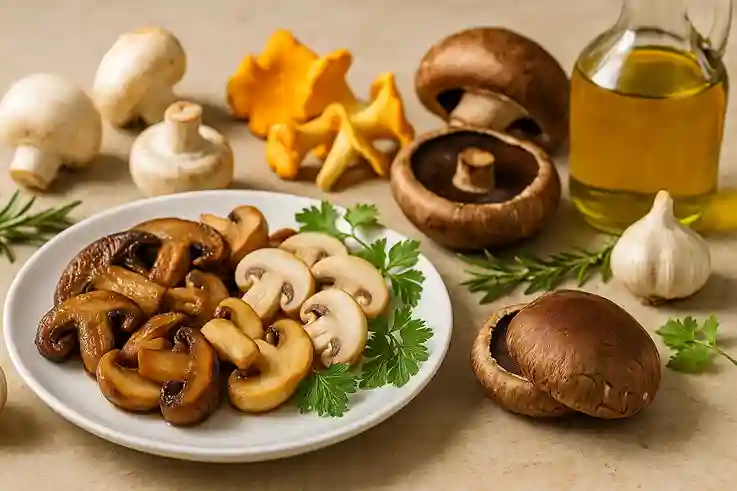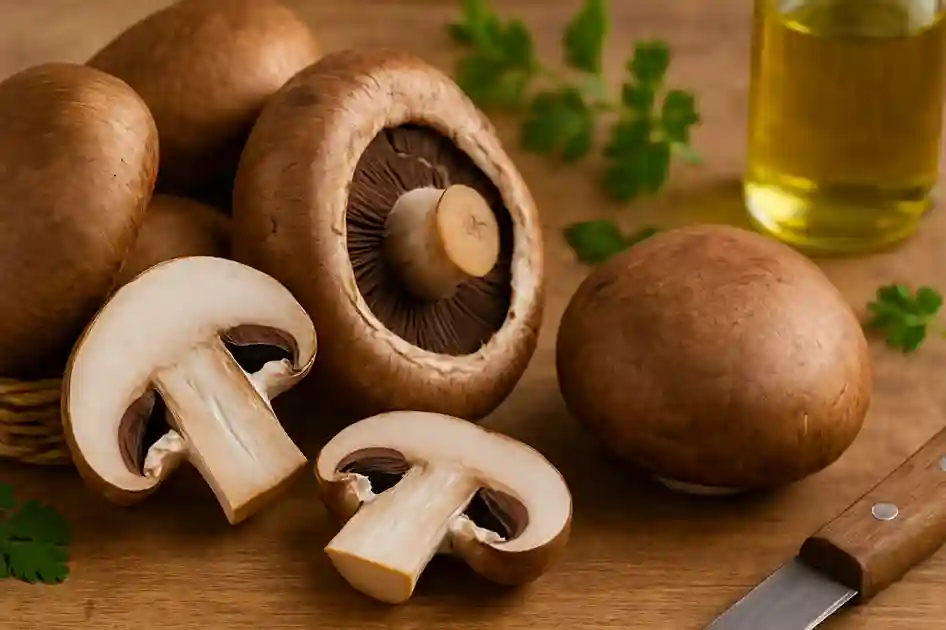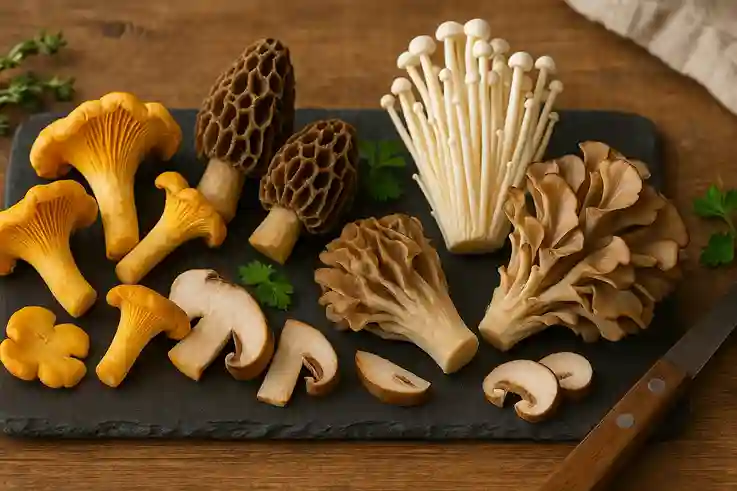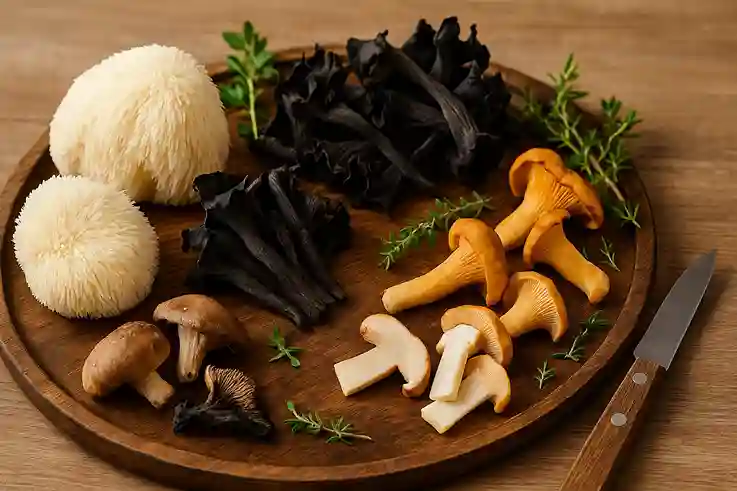Types of edible mushrooms are a favorite in U.S. kitchens because they deliver both taste and nutrition. These fungi go beyond being just another ingredient. They offer fiber, protein, and antioxidants that help support everyday health. Their versatility makes them shine in many meals. You can sauté them for pasta, grill them for burgers, or add them to soups for depth.
Each mushroom variety brings a distinct flavor. Button mushrooms taste mild and earthy, while shiitakes deliver a rich, meaty note. Oyster mushrooms stay delicate, and portobellos add a bold, smoky touch. This range of flavors helps home cooks and chefs create dishes that feel both comforting and unique.
Beyond taste, mushrooms adapt to many diets. They work well for vegetarians, people cutting back on meat, and anyone seeking healthy, filling meals. Because of this flexibility, mushrooms have become a reliable ingredient in kitchens across the United States.
In this guide, you’ll explore types of edible mushrooms that stand out for their taste and uses. Some are familiar, like button or portobello. Others, like morels and chanterelles, feel more exotic and rare. Together, they prove why mushrooms continue to be one of the most loved foods.
What Makes Mushrooms a Favorite Food?
Mushrooms earn their place in U.S. kitchens because they balance health and flavor. They deliver protein, fiber, and antioxidants that help support strong immunity and heart health. With few calories and no cholesterol, mushrooms fit into nearly any diet plan.

Beyond nutrition, mushrooms enhance dishes across global cuisines. Italian cooking highlights mushrooms in pasta sauces and risottos. Asian meals often feature shiitake or enoki in soups and stir-fries. American kitchens use portobellos as hearty burger replacements or button mushrooms in comforting stews. Their ability to cross cuisines keeps them valuable in both home and restaurant cooking.
Mushrooms also fit seamlessly into daily meals. You can add sliced creminis to scrambled eggs, grill portobellos for lunch, or roast maitakes for dinner sides. They adapt to many cooking methods, which makes them both easy and exciting to use. With so many options, mushrooms remain one of the most versatile and reliable foods for everyday eating.
Common Types of Edible Mushrooms
These mushrooms are widely available in U.S. grocery stores and farmers’ markets. They are affordable, versatile, and easy to cook with. Many people start with these common varieties before exploring gourmet or exotic types.
Button Mushrooms
Button mushrooms are the most common variety found in the United States. Their mild flavor makes them approachable for beginners and versatile for experienced cooks. They blend smoothly into many dishes without overwhelming other ingredients. Because they absorb flavors quickly, they adapt well to herbs, spices, and sauces. Many people enjoy them in eggs, pasta, soups, or salads, making button mushrooms an easy and reliable choice for everyday meals.

Health Benefits of Button Mushrooms
Button mushrooms may look simple, but they provide impressive health benefits. They are naturally low in calories, cholesterol-free, and high in essential nutrients. Their fiber supports digestion and helps maintain a healthy gut. Protein in button mushrooms contributes to muscle repair and growth, making them useful for balanced diets.
Additionally, button mushrooms are rich in B vitamins like riboflavin and niacin, which support energy production and brain function. They also contain selenium and potassium, minerals that play a role in heart health and immunity. With these nutrients, button mushrooms make everyday meals both flavorful and nourishing.
Cremini Mushrooms
Cremini mushrooms are often called “baby bellas” because they are the younger form of portobello mushrooms. They have a deeper, earthier flavor compared to button mushrooms, which gives dishes a richer taste. Therefore, they are ideal for soups, sauces, and roasted vegetable dishes. Their firmer texture also holds up well during longer cooking methods, making them a dependable choice for hearty meals.

Health Benefits of Cremini Mushrooms
Cremini mushrooms, also called baby bellas, offer strong nutritional value along with their earthy flavor. They are a good source of fiber, which supports digestion and helps keep you feeling full. Their protein content aids muscle repair and provides steady energy throughout the day.
Moreover, cremini mushrooms are rich in antioxidants that protect cells from damage. They also supply important minerals like copper and selenium, which support brain health, metabolism, and immunity. With these combined benefits, cremini mushrooms are both a flavorful and health-focused addition to everyday meals.
Portobello Mushrooms
Portobello mushrooms are the fully mature form of cremini mushrooms. Their large, hearty caps provide a dense, meaty texture that satisfies. Consequently, many cooks use them as a plant-based substitute for burgers or steak. When grilled or roasted, portobellos deliver bold flavor and a rich, satisfying bite.

Health Benefits of Portobello Mushrooms
Portobello mushrooms are valued for both their hearty texture and their nutritional profile. They are naturally low in fat and calories, yet they provide filling protein that supports muscle strength and recovery. Their fiber also aids digestion and helps maintain steady blood sugar levels.
Furthermore, portobellos are a strong source of B vitamins, potassium, and phosphorus. These nutrients contribute to bone health, heart function, and energy production. Because they are large and satisfying, portobellos also serve as an excellent plant-based alternative to meat while still offering key nutrients.
Nutritional Values of Common Edible Mushrooms (per 100g)
| Mushroom Type | Calories | Protein (g) | Fiber (g) | Key Nutrients |
|---|---|---|---|---|
| Button | 22 | 3.1 | 1.0 | B vitamins, selenium, potassium |
| Cremini | 25 | 3.1 | 1.2 | B vitamins, selenium, copper |
| Portobello | 29 | 3.6 | 1.3 | B vitamins, potassium, phosphorus |
Gourmet Types of Edible Mushrooms
Some mushrooms are prized by chefs for their bold flavors and unique textures. These gourmet varieties appear often in restaurant dishes, but they’re also becoming more available in U.S. grocery stores.

Shiitake Mushrooms
Shiitake mushrooms are well known for their rich, savory umami flavor. This taste makes them a favorite in Asian-inspired dishes. Moreover, they add depth to stir-fries, soups, and sauces without much effort. Thanks to their meaty texture, shiitakes also enhance vegetarian meals, providing both flavor and substance.
Health Benefits of Shiitake Mushrooms
Shiitake mushrooms are valued for their bold flavor and impressive nutrients. They are low in calories but provide protein and fiber that support digestive health and steady energy. Their meaty texture makes them filling while still being light.
In addition, shiitakes are packed with compounds that support immunity, such as beta-glucans. They also contain B vitamins, copper, and selenium, which promote healthy blood, strong bones, and proper metabolism. With these combined nutrients, shiitake mushrooms are both delicious and highly beneficial for everyday health.
Oyster Mushrooms
Oyster mushrooms are prized for their delicate, slightly sweet flavor that feels light and refreshing. They are easy to prepare and cook very quickly, making them convenient for busy meals. Therefore, they are perfect for quick sautés or stir-fries that need flavor without long cooking. Their tender texture also pairs beautifully with noodles, grains, and light sauces, adding balance to simple dishes.
Health Benefits of Oyster Mushrooms
Oyster mushrooms are light in flavor yet packed with nutrients that support overall health. They provide fiber for digestion and protein that helps maintain energy and muscle strength. Their delicate texture makes them satisfying without being heavy.
Moreover, oyster mushrooms are rich in antioxidants and compounds that support heart health by helping reduce cholesterol levels. They also contain B vitamins, iron, and potassium, which contribute to brain function, blood health, and balanced metabolism. With these benefits, oyster mushrooms are both versatile in cooking and supportive of wellness.
Maitake Mushrooms
Maitake mushrooms, often called “hen of the woods,” have an earthy and woodsy taste that stands out. They roast beautifully in the oven and develop a crisp, flavorful edge. Additionally, many people enjoy maitakes for their immune-supporting nutrients, which makes them both delicious and nourishing.
Health Benefits of Maitake Mushrooms
Maitake mushrooms, often called “hen of the woods,” are admired for their flavor and nutritional strength. They provide fiber that aids digestion and protein that supports muscle repair and steady energy. Their earthy taste makes them both nourishing and enjoyable.
Additionally, maitake mushrooms are rich in beta-glucans, compounds known to strengthen immunity and regulate blood sugar levels. They also contain vitamin D, niacin, and antioxidants, which promote bone health, cellular protection, and balanced metabolism. With these benefits, maitakes are a smart choice for both flavor and wellness.
Nutritional Values of Gourmet Edible Mushrooms (per 100g)
| Mushroom Type | Calories | Protein (g) | Fiber (g) | Key Nutrients |
|---|---|---|---|---|
| Shiitake | 34 | 2.2 | 2.5 | B vitamins, copper, selenium |
| Oyster | 33 | 3.3 | 2.3 | B vitamins, iron, potassium |
| Maitake | 31 | 1.9 | 2.7 | Vitamin D, antioxidants, niacin |
Rare Types of Edible Mushrooms Worth Trying
Some mushrooms stand out because they are seasonal or less common in everyday markets. These rare varieties bring exciting flavors and textures that many food lovers seek out.

Morel Mushrooms
Morel mushrooms are prized for their nutty, earthy flavor that many food lovers find unforgettable. They appear mainly in spring and are often foraged rather than farmed, which makes them rare. As a result, morels are highly sought after by chefs who value their unique taste. Many cooks sauté them gently with butter or pair them with cream-based sauces to highlight their richness.
Health Benefits of Morel Mushrooms
Morel mushrooms are treasured not only for their nutty flavor but also for their strong nutritional profile. They provide fiber that supports digestion and protein that helps maintain muscle health. Their low calorie count makes them a smart addition to balanced meals.
As a result, morels supply key nutrients like vitamin D, iron, and manganese, which strengthen bones, improve energy, and support immunity. Their rare availability makes them a seasonal treat, but their benefits make them worth seeking out each spring.
Chanterelle Mushrooms
Chanterelle mushrooms are easy to recognize because of their golden color and trumpet-like shape. Their fruity aroma carries a slight peppery bite that sets them apart from other mushrooms. Therefore, many cooks choose to sauté chanterelles lightly, which helps preserve their delicate flavor and appealing texture.
Health Benefits of Chanterelle Mushrooms
Chanterelle mushrooms are recognized for their golden color and delicate, fruity flavor, but they also deliver important nutrients. They are naturally low in calories, while their fiber supports digestion and satiety. Their small amount of protein contributes to muscle health and energy balance.
Therefore, chanterelles are valued for their high levels of vitamin D, potassium, and copper. These nutrients help strengthen bones, regulate blood pressure, and support healthy blood cells. With this mix of taste and nourishment, chanterelle mushrooms make a seasonal ingredient that benefits both flavor and wellness.
Enoki Mushrooms
Enoki mushrooms are easy to spot with their long, thin stems and small, delicate caps. Their crisp texture makes them an excellent addition to soups, salads, and light stir-fries. Moreover, they cook quickly and bring a mild, slightly sweet taste that balances stronger flavors in many dishes.
Health Benefits of Enoki Mushrooms
Enoki mushrooms are recognized for their crisp texture and mild, slightly sweet flavor, but they also provide strong nutritional value. They are low in calories and offer fiber that supports digestion along with protein that helps maintain energy. Their lightness makes them easy to enjoy in many meals.
Moreover, enoki mushrooms are rich in B vitamins, phosphorus, and antioxidants. These nutrients contribute to healthy nerves, stronger bones, and cellular protection. With their simple flavor and solid health profile, enoki mushrooms serve as both a versatile ingredient and a nourishing choice.
👉 For detailed nutrition information on white button, oyster, shiitake, enoki, portobello, cremini, and maitake mushrooms, see the USDA’s Nutrient Data on Mushrooms Updated report.
Nutritional Values of Rare Edible Mushrooms (per 100g)
| Mushroom Type | Calories | Protein (g) | Fiber (g) | Key Nutrients |
|---|---|---|---|---|
| Morel | 31 | 3.1 | 2.8 | Vitamin D, iron, manganese |
| Chanterelle | 38 | 1.5 | 3.8 | Vitamin D, potassium, copper |
| Enoki | 37 | 2.7 | 2.7 | B vitamins, phosphorus, antioxidants |
Cooking Tips for Edible Mushrooms
Cooking edible mushrooms properly helps you enjoy both flavor and nutrition. Use these simple tips to get the best results.
How to Clean Edible Mushrooms Safely
To start, wipe edible mushrooms gently with a damp cloth or use a soft brush to remove dirt. This method keeps their texture firm and prevents excess water from seeping inside. Because mushrooms act like sponges, soaking them in water causes them to absorb moisture and lose their natural bite. By cleaning them carefully, you prepare mushrooms for cooking while protecting both flavor and quality.
Best Cooking Methods for Edible Mushrooms
Sautéing edible mushrooms in olive oil highlights their earthy flavors and works well for quick meals. Grilling adds a smoky depth that creates a hearty, meaty bite. Meanwhile, roasting concentrates flavor, reduces moisture, and gives mushrooms a firm, satisfying texture. Each method brings out different qualities, making mushrooms adaptable to many recipes.
Perfect Pairings with Edible Mushrooms
Edible mushrooms pair beautifully with fresh herbs like thyme, rosemary, and parsley, which enhance their earthy flavor. They also work well with meats such as chicken or beef, adding depth and richness to simple dishes. Additionally, grains like rice, quinoa, and barley create hearty bases that balance mushrooms and turn them into complete, satisfying meals.
Sustainable Mushroom Farming in the U.S.
Mushrooms are more than versatile ingredients—they are also one of the most eco-friendly crops grown in the United States. Their farming requires less land compared to many vegetables, and they thrive in controlled environments that minimize resource waste. Therefore, mushroom cultivation is often seen as a sustainable model for future food production.
One major benefit is their low water usage. Producing one pound of mushrooms requires far less water than crops like lettuce or broccoli. Mushrooms are also grown indoors year-round, which reduces dependence on unpredictable weather and allows consistent harvests.
Another advantage is waste reduction. Mushroom growers often use agricultural byproducts such as corn cobs, straw, and hay as growing material. Once the crop is harvested, the leftover compost can return to farms as organic fertilizer, completing the cycle.
A growing innovation in the U.S. is vertical farming. This method stacks mushroom beds in tall layers inside climate-controlled buildings. Vertical farming maximizes space, lowers energy costs, and increases production efficiency. It’s an example of how mushroom farming adapts modern technology to stay both sustainable and scalable.
“Mushrooms are the earth’s way of reminding us that hidden treasures grow in unexpected places.” – Anonymous
FAQs about Types of Edible Mushrooms
Conclusion On Types of Edible Mushrooms
Exploring different types of edible mushrooms opens the door to new flavors, textures, and health benefits. From common varieties like button and cremini to rare options such as morel or chanterelle, each mushroom adds something unique to your meals. Their versatility makes them easy to use in everyday dishes while also elevating gourmet recipes.
Ultimately, mushrooms prove that nutritious food can also be exciting, satisfying, and sustainable. Whether you enjoy them sautéed, grilled, or roasted, they offer endless possibilities in the kitchen.
👉 Now it’s your turn: Which types of edible mushrooms do you enjoy most? Have you tried any rare varieties at home?
Share your experiences and favorite recipes in the comments below — your insights could inspire other readers to try something new!

Alexia Greene is a health blogger dedicated to making wellness simple, practical, and accessible for everyone. With a strong background in nutrition and healthy living, she writes about balanced diets, fitness tips, and mindful habits that support long-term well-being. Alexia’s mission is to empower readers with trustworthy information and actionable steps they can use in their everyday lives.
When she’s not writing, Alexia enjoys cooking wholesome meals, practicing yoga, and exploring new ways to live a healthier lifestyle. Her approachable style and evidence-based advice make her a trusted voice in the world of health and wellness blogging.


